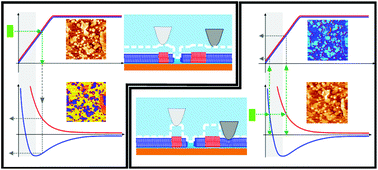True non-contact atomic force microscopy imaging of heterogeneous biological samples in liquids: topography and material contrast
Abstract
The present work analyses how the tip–sample interaction signals critically determine the operation of an Atomic Force Microscope (AFM) set-up immersed in liquid. On heterogeneous samples, the conservative tip–sample interaction may vary significantly from point to point – in particular from attractive to repulsive – rendering correct feedback very challenging. Lipid membranes prepared on a mica substrate are analyzed as reference samples which are locally heterogeneous (material contrast). The AFM set-up is operated dynamically at low oscillation amplitude and all available experimental data signals – the normal force, as well as the amplitude and frequency – are recorded simultaneously. From the analysis of how the dissipation (oscillation amplitude) and the conservative interaction (normal force and resonance frequency) vary with the tip–sample distance we conclude that dissipation is the only appropriate feedback source for stable and correct topographic imaging. The normal force and phase then carry information about the sample composition (“chemical contrast”). Dynamic AFM allows imaging in a non-contact regime where essentially no forces are applied, rendering dynamic AFM a truly non-invasive technique.



 Please wait while we load your content...
Please wait while we load your content...